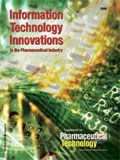The Role of Process Simulation and Scheduling Tools in the Development and Manufacture of Pharmaceutical Products
This article discusses the role of process simulation and scheduling tools in the development and manufacture of pharmaceutical products.
Global competition in the pharmaceutical industry and increasing demands by governments and citizens for affordable medicines have focused the industry's attention on manufacturing efficiency. In this new era, improvements in process and product development approaches and the streamlining of manufacturing operations can have a profound effect on the bottom line. Process simulation and scheduling tools can play an important role in this endeavor. The function of such tools in the development and manufacture of active pharmaceutical ingredients (APIs) has been reviewed (1–8). This article focuses on the role of process simulation and scheduling tools in the development and manufacture of pharmaceutical products.
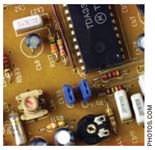
During process development, process simulation software is used to perform the following tasks:
- represent the entire process on the computer;
- perform material and energy balances;
- estimate the size of equipment;
- calculate demand for utilities as a function of time;
- estimate a process's cycle time;
- perform cost analysis;
- assess the environmental impact and so forth.
The availability of a good computer-based model improves the understanding of the entire process by team members and facilitates communication. What-if and sensitivity analyses are greatly facilitated by such tools. The objective of such studies is to evaluate the effect of critical parameters on various key performance indicators (KPIs) such as production cost, cycle times, and plant throughput. If there is uncertainty for particular input parameters, sensitivity analysis can be supplemented with Monte Carlo simulation to quantify the effect of uncertainty. Cost analysis, especially capital cost estimation, facilitates decisions related to in-house manufacturing versus outsourcing. An estimation of the cost-of-goods identifies expensive processing steps and such information guides R&D work in a judicious manner.
When a process is ready to move from development to manufacture, process simulation facilitates technology transfer and process fitting. A detailed computer model provides a thorough description of a process in a format that can be readily understood and adjusted by the recipients. Process adjustments are commonly required when a new process is moved into an existing facility that does not contain equipment that is ideally sized for the new process. The simulation model is used to adjust batch sizes, determine the cycling of certain steps (for equipment that cannot handle a batch in one cycle), estimate recipe cycle times, and so forth.
Production scheduling tools play an important role in large- and clinical-scale manufacturing alike. They are used to generate production schedules on an on-going basis and in a manner that does not violate constraints related to the limited availability of equipment, labor resources, utilities, or inventories of materials. Production-scheduling tools close the gap among enterprise resource planning (ERP) and materials requirements planning (MRP) II tools and the plant floor (9). Production schedules generated by ERP/MRP II tools typically are based on coarse process representations and approximate plant capacities. As a result, solutions generated by these tools may not be feasible, especially for multiproduct facilities that operate at high capacities. This situation often leads to late orders that require expediting or to large inventories to maintain customer responsiveness. Lean manufacturing principles such as just-in-time production, low work-in-progress (WIP), and low product inventories cannot be implemented without good production scheduling tools that can accurately estimate capacity.
Commercially available simulation and scheduling tools
Process simulation programs, also known as process simulators, have been in use in the chemical and petrochemical industries since the early 1960s. Established simulators for those industries include Aspen Plus and HYSYS (Aspen Technology, Inc., Cambridge, MA), ChemCAD (Chemstations, Inc., Houston, TX), and PRO/II (SimSci-Esscor, Inc., Lake Forest, CA).
These simulators have been designed to model primarily continuous processes and their transient behavior for process control purposes. Most pharmaceutical products, however, are produced in batch and semicontinuous mode. Such processes are best modeled with batch process simulators that account for time-dependency and sequencing of events. The first simulator specific to batch processes was Batches from Batch Process Technologies, Inc. (West Lafayette, IN). It was commercialized in the mid-1980s. All of its operation models are dynamic and simulation always involves the integration of differential equations over a period of time. In the mid-1990s, Aspen Technology introduced Batch Plus, a recipe-driven simulator that targeted batch pharmaceutical processes. Around the same time, Intelligen, Inc. (Scotch Plains, NJ) introduced SuperPro Designer. The initial focus of SuperPro was on the production of APIs (synthetic and biosynthetic) and specialty chemicals. Over the years, its scope has been extended to include process modeling for the production of pharmaceutical and consumer products.
Discrete-event simulators also have found applications in the pharmaceutical industries, especially in the modeling and debottlenecking of packaging operations. Established tools of this type include ProModel (ProModel Corporation, Orem, UT), Arena and Witness (Rockwell Automation, Inc., Milwaukee, WI), Extend (Imagine That, Inc., San Jose, CA), and FlexSim (FlexSim Software Products, Inc., Orem, UT). The focus of models developed with such tools is usually on the minute-by-minute time-dependency of events and the animation of the process. Material balances, equipment sizing, and cost analysis tasks are usually out of the scope of such models. Some of these tools are quite customizable and third-party companies occasionally use them as platforms to create industry-specific modules. For instance, BioPharm Services, Ltd. (Bucks, UK) has created a module with emphasis on biopharmaceutical processes that runs on top of Extend.
Microsoft's MS Excel is another common platform for creating models for pharmaceutical processes that focus on material balances, equipment sizing, and cost analysis. Some companies have even developed models in Excel that capture the time-dependency of batch processes. This is typically done by writing extensive code (e.g., macros and subroutines) in Visual Basic for Applications that comes with Excel. K-TOPS from Alfa Laval Biokinetics, Inc. (Philadelphia, PA) belongs to this category.
In terms of production scheduling, established tools include Optiflex (i2 Technologies, Inc., Irving, TX), SAP APO (SAP AG, Walldorf, Germany), ILOG Plant PowerOps (ILOG SA, Gentilly, France), and Aspen SCM (formerly Aspen MIMI) (Aspen Technology, Inc., Cambridge, MA). Their success in the pharmaceutical industry, however, has been rather limited so far. Their primary focus on discrete manufacturing (as opposed to batch chemical manufacturing) and their approach to scheduling from a mathematical optimization viewpoint are some reasons for the limited market penetration.
SchedulePro (Intelligen, Inc.) is a new finite-capacity scheduling tool that focuses on the scheduling of batch and semicontinuous chemical and related processes. It is a recipe-driven tool with emphasis on the generation of feasible solutions that can be readily improved by a user in an interactive manner.
Examples that illustrate the benefits from the use of simulation and scheduling tools in the production of pharmaceutical products follow.
Modeling and analysis of a tablet manufacturing process
Common forms of pharmaceutical products include tablets, capsules, ointments, creams, and solutions in syringes and vials. Their preparation involves mixing the API with various excipients that increase the product's shelf life and facilitate the delivery of the API. The manufacturing of injectable products involves the filling of syringes or vials under aseptic conditions.
A tablet manufacturing process will be used as a representative example to demonstrate the use of process simulation and scheduling tools in the development and manufacture of finished pharmaceutical products. To model an integrated process using SuperPro Designer, a user starts by developing a flowsheet that represents the overall process. Figure 1, for instance, displays part of the flowsheet of a tablet manufacturing process. The flowsheet is developed by putting together the required unit procedures and joining them with material flow streams. Next, the user initializes the flowsheet by registering the various materials that are used in the process and specifying operating conditions and performance parameters for the various operations.

Figure 1: A flowsheet for a pharmaceutical tablet manufacturing process.
Most pharmaceutical processes operate in batch or semi-continuous mode. In contrast, petrochemical and other industries that handle large throughputs use continuous processes. In continuous operations, a piece of equipment performs the same action all the time. In batch processing, on the other hand, a piece of equipment goes through a cycle of operations. For instance, a slurry preparation step (P-1 in V-101) includes the following operations (see Figure 2): sanitize, charge USP water, charge sucrose, charge API, agitate, transfer to mill recirculation vessel, and flush (clean equipment).

Figure 2: The operations associated with the first unit procedure of Figure 1.
In the SuperPro system, the set of operations that make up a processing step is called a unit procedure (as opposed to a unit operation). The individual tasks contained in a procedure (e.g., charge, heat, agitate) are called operations. A unit procedure is represented on the screen with a single equipment-looking icon. In essence, a unit procedure is the recipe that describes the sequence of actions required to complete a single processing step. Figure 2 displays the dialog through which the recipe of a vessel unit procedure is specified. On the left-hand side of that dialog, the program displays the operations that are available in a vessel procedure; on the right-hand side, it displays the registered operations. The significance of the unit procedure is that it enables a user to describe and model the various activities of batch processing steps in detail.
For every operation within a unit procedure, the simulator includes a mathematical model that performs material and energy balance calculations. Based on the material balances, it performs equipment-sizing calculations. If multiple operations within a unit procedure dictate different sizes for a certain piece of equipment, then the software reconciles the different demands and selects an equipment size that is appropriate for all operations. The equipment is sized large enough so that it will not be overfilled during any operation, but no larger than necessary (to minimize capital costs). If the equipment size is specified by the user, then the simulator ensures that the vessel is not overfilled. In addition, the tool checks to ensure that the vessel contents will not fall below a user-specified minimum volume (e.g., a minimum stir volume) for applicable operations.
In addition to material balances, equipment sizing, and cycle-time analysis, the simulator can be used to carry out cost-of-goods analysis and project economic evaluation. The sections that follow provide illustrative examples of the previously described operations.
Having developed a good model using a process simulator, the user may begin experimenting on the computer with alternative process setups and operating conditions. This process may reduce the costly and time-consuming laboratory and pilot-plant effort. Of course, the garbage-in, garbage-out principle applies to all computer models. If critical assumptions and input data are incorrect, so will be the outcome of the simulation. Consequently, a certain level of model verification is necessary. In its simplest form, a review of the results by an experienced engineer can play the role of verification.
Process description. The objective of this example is to illustrate how batch process simulators can be used to model, visualize, and analyze fine pharmaceutical processes. It focuses on a process for manufacturing pharmaceutical tablets in an existing facility for which equipment sizes are known. Such tools, however, also can be used to size equipment during the design of new facilities.
The entire flowsheet of the process is shown in Figure 1. A batch begins by charging 705 L of USP water into a 1500-L mixing tank (V-101), then adding 200 kg of sucrose and 400 kg of API. The suspension is agitated thoroughly for 8 h. Then, the suspension is transferred into another 1500-L tank (V-102) that feeds the nanomill (NM-101). The role of the nanomill is to homogenize the suspension thoroughly and reduce the API particles to nanometer scale. This step is required because this specific API is insoluble in water. The suspension is pumped through the nanomill twice during a 22-h period. After homogenization is completed, the material is transferred into a 2000-L tank (V-103) where 70 kg of an excipient and 50 kg of a flavoring agent are added along with 100 L of USP water. The material is agitated thoroughly for 5 h. Then, the material is transferred into another 2000-L tank (V-105) that feeds the granulator. A stabilizer solution is prepared in a 500-L tank (V-104) by dissolving 80 kg of the stabilizer into 180 L of USP water. The stabilizer solution is combined with the homogenized solution in V-105.
In preparation for the granulation–drying step, mannitol is added into the granulator bowl (GRN-101). Then, the suspension is sprayed into the granulator's chamber at a rate of 120 kg/h. Almost all of the water is removed (final water content is 0.005% w/w). The granulated and dried material is removed from the granulator and stored into several 50-L mobile containers (MC-101). The granulator handles a batch of homogenized material in two cycles because its limited bowl volume can hold only ;1350 L (or 600 kg) of bulk solids.
The mobile tanks are moved into the tablet press room. The tablet press (TBP-101) makes 0.5-g tablets at a rate of 250,000 tablets/h. The processing of a batch is completed in approximately 9.6 h. The tablets are collected in a storage bin (DB-101).
Then, a tablet coater (TB-101) coats the tablets with a material that gives them a sweet taste and a blue color. A batch is processed in four cycles because the coater can handle as much as ;300 kg of tablets per batch. The coating solution is prepared ahead of time in a 150-L mixing tank (V-106). Approximately 10 mg of coating solution is required per tablet. A coating cycle takes about 6 h. Warm air is pumped through the drum of the coater during the coating process to vaporize the water of the coating solution. The coated tablets are stored in drums (not shown in the flowsheet) and taken to the packaging area.
All the unit procedures up to the granulator (P-7/GRN-101) require a sanitization operation before the main processing activities and a clean-in-place (CIP) operation after the main processing activities.
Table I provides information about raw-material requirements for the entire process. A batch consists of approximately 2.4 million product tablets that have a total mass of around 1224 kg. The API is approximately 33% of the final tablet mass. Notice the large amount of hot USP water, which is consumed for equipment cleaning.
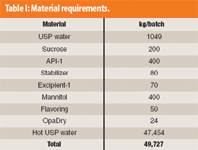
Table I: Material requirements.
Process scheduling and resource tracking. Figure 3 displays the equipment occupancy chart for four consecutive batches (each color represents a different batch). The recipe-scheduling summary dialog is shown on the top right hand corner of the chart. The recipe batch time is approximately 102 h, which is the total time between the start of the batch's first step and the end of the batch's last step. Because most of the equipment items are used for shorter periods within a batch, however, a new batch is initiated every 30 h, which is known as the recipe cycle time. The minimum possible recipe cycle time is 29.6 h. Multiple bars of the same color on the same line represent reuse (sharing) of equipment by multiple procedures or operations. The single CIP skid (top line in Figure 3) is the only shared equipment in this process. White space between procedure bars represents idle time. White space within a procedure bar represents waiting time. For instance, the white spaces in the procedure bars of V-103 and V-104 represent waiting for cleaning because of the constraints imposed by the single CIP skid. This type of chart is an invaluable tool for visualizing cycle times and scheduling bottlenecks.

Figure 3: Equipment occupancy chart for four consecutive batches.
Figure 4 displays the operations Gantt chart which provides more detailed scheduling information. Notice, for instance, the duration of the TRANSFER-OUT-1 operation in P-6 (V-105) that feeds material to the granulator (P-7/GRN-101). The granulator handles a batch in two cycles because of its limited bowl volume. The duration of TRANSFER-OUT-1 in P-6 is from the start of the first granulation operation in P-7 to the end of the second granulation operation in P-7. In reality, there are two shorter transfer-out operations (synchronized to the two granulation operations in P-7), but for simplicity, SuperPro represents that with a single transfer-out operation that has the correct total duration.
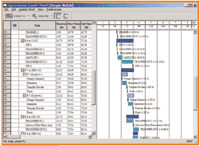
Figure 4: The operations Gantt chart.
Process scheduling in the context of a simulator is fully process driven and the effect of changes can be analyzed in a matter of seconds. For instance, the effect of an increase in batch size (that affects the duration of charge, milling, granulation, and other scale-dependent operations) on the recipe cycle time and the number of batches can be evaluated instantly. Because of many interacting factors involved with even a relatively simple process, simulation tools that allow users to describe their processes in detail and to perform what-if analyses quickly can be extremely useful.
Another characteristic of batch processing is the variable demand for resources (e.g., labor, utilities, and raw materials) as a function of time. For instance, Figure 5 displays the demand for purified water (USP water) for eight consecutive batches. This demand includes USP water consumed for the CIP operations as well as USP water used for preparing the product mixture. The red lines represent the instantaneous demand whereas the green line represents the cumulative demand and corresponds to the y-axis on the right-hand side. The blue line corresponds to daily demand (the averaging period can be adjusted by a user). High-purity water is a common potential bottleneck in pharmaceutical processes. It is frequently used by multiple processing steps simultaneously in activities such as solution preparation and equipment cleaning. If not enough instantaneous (or cumulative) capacity is available, one or more process steps may be delayed, possibly with severe consequences. During the design of new facilities or retrofit of existing ones, the information provided by such charts is used for sizing utility systems.

Figure 5: USP water demand for eight consecutive batches.
In addition to the instantaneous demand of resources, the simulator provides the means to track the volumetric usage of all vessels throughout the batch cycle. This allows a user to track maximum working volumes over time and ensure that the minimum stir volume is always met at any relevant point in a process. The volume content of vessels is also used in sizing new vessels and calculating the capacity usage of existing vessels.
Cost analysis. Cost analysis and project economic evaluation are important for several reasons. For a new product, if the company lacks a suitable manufacturing facility with available capacity, it must decide whether to build a new plant or outsource the production. Building a new plant is a major capital expenditure and a lengthy process. To make a decision, management must have information about the capital investment required and time to complete the facility. When production is outsourced, a cost-of-goods analysis serves as a basis for negotiation with contract manufacturers. A sufficiently detailed computer model can be used as the basis for the discussion and negotiation of the terms. Contract manufacturers usually base their estimates on the requirements of equipment use and labor per batch, which is information provided by a good model. SuperPro performs thorough cost analysis and project economic evaluation calculations. It estimates capital as well as operating cost. The cost of equipment is estimated using built-in cost correlations that are based on data derived from several vendors and literature sources. The fixed capital investment is estimated based on equipment cost and using various multipliers, some of which are equipment specific (e.g., installation cost) and others are process specific (e.g., cost of piping, buildings). The approach is described in detail in the literature (7). The rest of this section provides a summary of the cost analysis results for this example process.
Table II shows the key economic evaluation results for this project. The fixed capital investment for a manufacturing facility of this size is nearly $145 million. The annual operating cost (assuming the facility is dedicated to a single product) is nearly $87 million, resulting in a unit production cost of $0.14/tablet. Assuming a product selling price of $0.25/tablet, the facility generates annual revenues of $160 million and has an attractive return on investment.
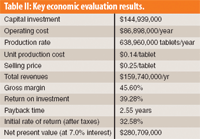
Table II: Key economic evaluation results.
Table III provides a breakdown of the manufacturing cost, including (two left columns) and excluding (two right columns) the cost of API. A purchasing price of $500/kg was assumed for the API, resulting in an annual API cost of $52.2 million. When the cost of the API is considered in the cost-of-goods, the cost of raw materials becomes the dominant cost (63% of total). If the cost of API is ignored, the facility overhead becomes the dominant item of the manufacturing cost (75% of total). In the latter case, the unit production cost drops to $0.05/tablet. That is representative of the incremental cost of contract manufacturers.
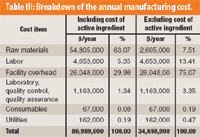
Table III: Breakdown of the annual manufacturing cost.
Cycle time reduction. In a batch manufacturing facility, the annual throughput equals the batch size times the number of batches that can be processed per year. Consequently, increasing the batch size or the number of batches per year increases the annual plant throughput.
Process simulation tools enable users to readily experiment with options that have the potential of increasing the batch size or reducing the cycle time. The base case process already operates at its maximum batch size (imposed by the granulator). Consequently, the only option for throughput increase is by reducing the cycle time of the time bottleneck equipment, which is the bin (DB-101) that supplies material to the tablet coater (TB-101). The availability of a second bin of the same size (e.g., DB-101b) that handles alternating batches will eliminate that bottleneck and shorten the recipe cycle time to 27.4 h (the cycle time of the base case is 30 h). The addition of a new bin shifts the time bottleneck to V-105, the tank that feeds the granulator. The addition of a new tank of the same size (e.g., V-105b) eliminates that bottleneck, reduces the recipe cycle time to 26.5 h, and shifts the bottleneck to V-102 (the tank that feeds the nanomill). Finally, the addition of a new nanomill feeding tank (V-102b) reduces the cycle time to 26 h.
Figure 6 shows the equipment occupancy chart after the addition of the new equipment (DB-101b, V-105b, and V-102b). The new cycle time is 13.3% shorter than the original. Is it worth installing two new blending tanks and a bin for a 13.3% cycle time reduction? The definitive answer to the question can be provided by performing a cost-and-benefits analysis using the simulator. Additional information about cycle time reduction and debottlenecking approaches and methodologies can be found in the literature (3).
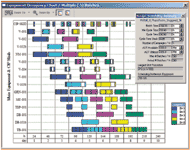
Figure 6: The equipment occupancy chart after the addition of the new equipment.
Uncertainty and variability analysis. Process simulation tools typically used for batch process design, debottlenecking, and cost estimation use deterministic (cause and effect) models. They model the "average" or "expected" situation commonly referred to as the base case or most likely scenario. Modeling several cases can help determine the range of performance with respect to key process parameters. Nonetheless, such an approach does not account for the relative likelihood of the various cases.
Monte Carlo simulation is a practical means of quantifying the risk associated with uncertainty in process parameters. In the Monte Carlo simulation, uncertain input variables are represented with probability distributions. A simulation calculates numerous scenarios of a model by repeatedly picking values from a user-defined probability distribution for the uncertain variables and using those values for the model to calculate and analyze the outputs in a statistical way to quantify risk.
For models developed in SuperPro, a Monte Carlo simulation can be performed by combining SuperPro with the Crystal Ball application (Decissioneering, Inc., Denver, Colorado). Crystal Ball is an Excel add-in application that facilitates Monte Carlo simulation. It enables a user to designate the uncertain input variables, specify their probability distributions, and select the output (decision) variables for which values are recorded and analyzed during the simulation. For each simulation trial (scenario) Crystal Ball generates random values for the uncertain input variables selected in frequency dictated by their probability distributions using the Monte Carlo method. Crystal Ball also calculates the uncertainty in the outputs in terms of their statistical properties, mean, median, mode, variance, standard deviation, and frequency distribution.
As explained in the previous section, the storage units that supply material to the tablet coater, the granulator, and the nanomill have the longest cycle times and therefore are the most likely scheduling bottlenecks. Because the process operates with a cycle time of 30 h (which is very close to the minimum of 29.6 h), variability in the tablet coating, granulation, and nanomilling operations that determine the cycle times of their feeding units may have an effect on the recipe cycle time. Likely sources of variability include random power outages and equipment failures, availability of operators, differences in skills of operators that affect setup and operation of equipment. For illustrative purposes, the Weibull distributions of Figure 7 (a, b, c) were assumed for the process times of tablet coating, granulation, and nanomilling, respectively. Their base case values are 6, 7.6, and 21.8 h, respectively. The coater has the longest cycle time among the three because it handles a batch in four cycles and each cycle lasts 6 h. If this type of analysis is done for an existing facility, historical data should be used to derive the probability distributions.
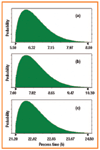
Figure 7: Assumed probability distributions for the process times of a) tablet coating, b) granulation, and c) nanomilling.
The decision (output) variable considered in this example is the recipe cycle time that determines the throughput of the facility. Figure 8 displays the results of the Monte Carlo simulation. The analysis reveals that the process can operate with a cycle time of less than 30 h with a certainty of 80% (blue area of Figure 8). If campaign production plans are based on the base case cycle time, the analysis reveals that production can be completed on time with a certainty of only 80%. Such findings can assist company management in the decision-making process. Additional information on Monte Carlo simulation and risk assessment can be found in the literature (10).
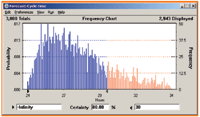
Figure 8: Calculated probability distribution for the cycle time of the entire process.
Production planning and scheduling
Pharmaceutical manufacturing facilities typically are equipped with multiple production lines that share utilities and labor resources. They also may share auxiliary equipment such as CIP skids, transfer panels, and delivery lines, and occasionally main equipment. They operate 24–7 or with other shift patterns. Production typically is campaigned. Considerable changeover time often is required between campaigns of different products.
Scheduling tools used in the pharmaceutical industry must quickly generate feasible solutions that respect all the major constraints. Such tools must be equipped with intuitive interfaces that enable the scheduler to visualize and easily modify the schedule. For instance, if a machine goes down or an operation is delayed, the scheduler must be able to quickly update the state of the system and generate a new feasible schedule.
Being able to perform "what-if" studies for capacity analysis exercises is another desirable feature. This is typically done by evaluating hypothetical production scenarios over a period of months to years. Such analyses can provide justifications for facility expansions or production outsourcing (if the current facility cannot meet expected future demand).
Results of scheduling tools are communicated to stakeholders through various charts and reports that provide information about tasks that must be executed during a certain time period. Figure 9 displays a production schedule in the form of a Gantt chart generated by SchedulePro. It corresponds to a tablet manufacturing facility equipped with two production lines (A and B). The two production lines use dedicated main equipment but share two CIP skids represented by the top two lines of the chart. The CIP skids can be used to clean equipment in either of the two lines. Line A includes a tablet coater, but line B does not. Line A operates seven days per week, whereas line B operates five days per week. The gray columns in line B represent 48-h weekend breaks. A 24-h changeover time is assumed between campaigns of different products to account for equipment adjustments and facility sanitization. For instance, the white rectangles between the first (blue-colored rectangles) and second (magenta-colored rectangles) campaigns of line A represent such a 24-h changeover time.
A production schedule is readily updated through the chart. Updates are required when a piece of equipment goes down or when the completion of a task is delayed. For the latter case, a user simply specifies the new completion time of the delayed operation and adjusts the schedule to eliminate conflicts. The adjustment can be made automatically by the tool or manually by a user by dragging and dropping activities in an interactive manner. In essence the chart becomes an intelligent electronic "Lego board" for which activities are linked and conflicts are readily identified and eliminated. Lego boards and other mechanisms of manual scheduling are still prevalent in many pharmaceutical manufacturing facilities. Interactive scheduling tools that resemble the look of Lego boards are usually adopted without much resistance by manufacturing personnel.
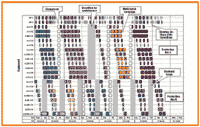
Figure 9: Production schedule in Gantt chart format.
A production schedule often is constrained not by its main equipment, but instead by the availability of labor and other resources. For instance, Figure 10 displays the labor demand for line A of the schedule of Figure 9. The blue lines represent the total instantaneous demand for labor.
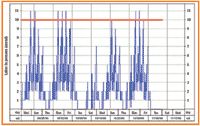
Figure 10: Line-A labor demand as a function of time.
The red line represents the maximum number of operators (10 in this case) in that production line. For short periods of time, eleven operators are needed. Scheduling tools enable manufacturing personnel to readily visualize and resolve such conflicts. The resolution of such conflicts is accomplished either by the scheduling algorithm or a user. It typically involves the delay of some operations that contribute to the peaks. If the facility uses few floating operators for lines A and B, such conflicts also can be resolved by using the floating operators during peak demand periods.
Constraints imposed by inventories of raw materials, intermediates, and final products and waste materials are handled in a similar manner. The tool calculates the level of materials and schedules accordingly (to avoid conflicts) or simply warns a user of conflicts due to inventories and lets him or her take corrective action.
In summary, scheduling tools enable manufacturing personnel to maintain a dynamic model of the entire facility that evolves with time and facilitates generation of production schedules that are feasible and easily modifiable. The end result is increased productivity, improved customer service, and reduced manufacturing cost.
Summary
Process simulation and production scheduling tools can play an important role throughout the lifecycle of product development and commercialization. In process development, process simulation tools are becoming increasingly useful as a means to analyze, communicate, and document process changes. During the transition from development to manufacturing, they facilitate technology transfer and process fitting. Production scheduling tools play a valuable role in manufacturing. They are used to generate production schedules based on the accurate estimation of plant capacity, thus minimizing late orders and reducing inventories. Such tools also facilitate capacity analysis and debottlenecking tasks.
The pharmaceutical industry has only recently begun making significant use of process simulation and scheduling tools. Increasingly, universities are incorporating the use of such tools in their curricula. In the future, we can expect to see an increased use of these technologies and tighter integration with other enabling IT technologies such as supply chain tools, manufacturing execution systems (MES), batch process control systems, and process analytical technology (PAT). The result will be more robust processes and efficient manufacturing leading to more affordable medicines.
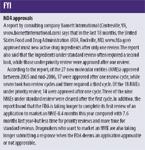
FYI
Victor Papavasileiou is a senior applications engineer with Intelligen Europe (Rijnsburgerweg, Netherlands), Alexandros Koulouris, PhD, is the managing director of Intelligen Europe (Thermi Thessaloniki, Greece), Charles Siletti, PhD, is the senior director of scheduling and planning applications of Intelligen, Inc. (Mt. Laurel, NJ), and Demetri Petrides, PhD*, is the president of Intelligen, Inc., 2326 Morse Avenue, Scotch Plains, NJ 07076, tel. 908.654.0088, fax 908.654.3866, dpetrides@intelligen.com.
*To whom all correspondence should be addressed.
Keywords: computer-aided process modeling, cost analysis, cycle time reduction, lean manufacturing, Monte Carlo simulation, pharmaceutical manufacturing, process simulation, production scheduling, risk assessment.
References
1. D.P. Petrides, A. Koulouris, and P.T. Lagonikos, "The Role of Process Simulation in Pharmaceutical Process Development and Product Commercialization," Pharm. Eng. 22 (1), 1 (2002).
2. D.P. Petrides and C.A. Siletti, "The Role of Process Simulation and Scheduling Tools in the Development and Manufacturing of Biopharmaceutical," Proceedings of the 2004 Winter Simulation Conference, R.G. Ingalls, et al., eds., pp. 2046–2051, (2004).
3. D. Petrides, A. Koulouris, and C. Siletti, "Throughput Analysis and Debottlenecking of Biomanufacturing Facilities, A Job for Process Simulators," BioPharm Int. 15 (8), 28–34, 64 (2002).
4. C.J. Thomas, "A Design Approach to Biotech Process Simulations," BioProcess Int. 1 (10), 2–9 (2003).
5. D.P. Petrides, J. Calandranis, and C.L. Cooney, "Bioprocess Optimization Via CAPD and Simulation for Product Commercialization," Gen. Eng. News, 16 (16), 24–40, (1996).
6. F. Hwang, "Batch Pharmaceutical Process Design and Simulation," Pharm. Eng. January–February, 28–43, (1997).
7. R.G. Harrison, et al., Bioseparations Science and Engineering (Oxford, UK, Oxford University Press, 2003).
8. J. Tan, et al., "Debottlenecking of a Batch Pharmaceutical Cream Production," Pharm. Eng. July–Aug. 72–82 (2006).
9. G. Plenert and B. Kirchmier, Finite Capacity Scheduling: Management, Selection, and Implementation (John Wiley & Sons, 2000).
10. E.C. Achilleos, J.C. Calandranis, and D.P. Petrides, "Quantifying the Impact of Uncertain Parameters in the Batch Manufacturing of Active Pharmaceutical Ingredients," Pharm. Eng. July–Aug. 34–40, (2006).
